
MAY CONTAIN NUTS

Search Shorpy
SHORPY ART

Framed or unframed, desk size to sofa size, printed by us in Arizona and Alabama since 2007. Explore now.
Join and Share
Ad-Free Shorpy
Shorpy is funded by you. Patreon contributors get an ad-free experience.
Learn more.

Recent comments
- Tough Guys
- Lost in Toyland
- And without gloves
- If I were a blindfolded time traveler
- Smoke Consumer Also Cooks
- Oh that stove!
- Possibly still there?
- What?!?
- $100 Reward
- Freeze Frame
- Texas Flyer wanted
- Just a Year Too Soon
- WWII -- Replacing men with women at the railroad crossing.
- Yes, Icing
- You kids drive me nuts!
- NOT An Easy Job
- I wonder
- Just add window boxes
- Icing Platform?
- Indiana Harbor Belt abides
- Freezing haze
- Corrections (for those who care)
- C&NW at Nelson
- Fallen Flags
- A dangerous job made worse
- Water Stop
- Passenger trains have right of way over freights?
- Coal
- Never ceases to amaze me.
- Still chuggin' (in model form)
Member Photos
The Shorpy
Print Emporium
Print Emporium
Search Shorpy
Search results -- 30 results per page
- Heart of Chicago: 1901
- Circa 1901. "The Heart of Chicago." An amazingly detailed (and smoky) tableau. 8x10 inch dry plate glass ... staircase, and it was not fire-protected. The Rookery in Chicago (Burnham and Root, 1885-1888) has a similar semicircular spiral ... have never seen anything like it before.
(The Gallery, Chicago, DPC, Streetcars) ... Posted by Dave - 07/20/2012 - 3:37pm -
![Heart of Chicago: 1901 Circa 1901. "The Heart of Chicago." An amazingly detailed (and smoky) tableau. 8x10 inch dry plate glass negative, Detroit Publishing Company. View full size.
Yes, it is a Spiral Staircase (or a Half-Spiral)That building, seen from the back, is the Hartford Building (Henry Ives Cobb, architect, 1893) at the southwest corner of Dearborn and Madison Streets. The early skyscrapers of the day usually had only one staircase, and it was not fire-protected. The Rookery in Chicago (Burnham and Root, 1885-1888) has a similar semicircular spiral staircase rising up one side of its interior light court.
Clark StreetArnheim the Tailor places this picture roughly at 155-157 South Clark Street.
You can also see the original version of the Morrison Hotel, which eventually was expanded to 40 stories. The building was razed in 1965 and is now the site of the First National Bank.
Fantastic View!The street running along the left side of the picture is Clark Street, looking north from approximately Monroe Street (Madison Street is the cross street with the blurry cable car train whizzing by). The notable tall buildings visible include: the Ashland Block (at the far left), the Schiller Building (to the right of the Ashland Block and partially obscured), the Unity Building (behind the "Boyce Building"), the Masonic Temple (the tallest one in sight) and the first Champlain Building (at the far right, next to the smaller building marked "Boston Store"). Needless to say, all of these have been demolished; the Champlain was the first to go - in 1916 - for the expansion of the Boston Store.
The Boston StoreSeems a little misplaced. Otherwise, I think the Boyce Building is still there.
If yer feeling ambitiousFor anyone wishing to re-create this view today, the photographer's vantage was the current site of Harris Bank at 111 West Monroe.
Do we still need Kodak?For the photogs who visit this site: are there digital cameras capable of capturing this scene, or do we still need large format cameras?
[A large- or medium-format digital camera would be more than up to the task. - Dave]
Too darn hotWith the obvious lack of AC units on the roofs, it's plain to see why so many windows were open. Offices with a window must have gone for a premium. Try to imagine the people in the inner offices trying to work wearing the heavy clothing of the time. "Of course you can use my fan, Myrtle."
[Inner offices in large buildings would have windows opening on an air shaft - Dave]
The JungleI can imagine Jurgis Rudkus walking aimlessly through these streets.
What is it?Does anyone have any idea what the part of the building is that has spiraling windows just to the left of the three awnings in the right third of the photo? I'd guess it houses a spiral staircase, but have never seen anything like it before.
(The Gallery, Chicago, DPC, Streetcars)](https://www.shorpy.com/files/images/4a07949a.thumbnail.jpg)
- Chicago Fog: 1942
- December 1942. "Chicago, Illinois. An unusually heavy fog in the early afternoon." Photo by ... superliner RMS Queen Mary , launched in 1936.
The Chicago Motor Coach Company had 100 of the Series 2 that were built in 1936, ... shown in New York, it kept the No. 104 but was relettered "Chicago Motor Coach." It stayed with Chicago and then was sold to Coast City ... Posted by Dave - 02/13/2017 - 1:03pm -
![Chicago Fog: 1942 December 1942. "Chicago, Illinois. An unusually heavy fog in the early afternoon." Photo by Jack Delano for the Office of War Information. View full size.
After That Bus, Watson!Save for the street furniture and bus markings, this could be London on a clear day back when everyone heated with coal. The buses' position on the street gives nothing away because they appear to be driving roughly in the middle -- a tendency toward which has not infrequently been ascribed to bus drivers on both sides of the water.
Royalty in the MistThe double-decker bus looming out of the fog is a Yellow Coach Model 720, which was nicknamed Queen Mary in a nod to the famous Cunard superliner RMS Queen Mary, launched in 1936.
The Chicago Motor Coach Company had 100 of the Series 2 that were built in 1936, and 40 of the Series 4 (fuel tank and battery location moved to eliminate fire hazards) that were built in 1938. They proved to be very useful and many of them were rebuilt several times before finally being retired in the early 1950s. The Fifth Avenue Coach Company bought 25 Series 3 and 35 Series 5, which were the New York versions of the Series 2 and Series 4 respectively, with some body changes.
According to New York Fifth Avenue Coach Company: 1885-1960 by Oliver J. Ogden, bus Number 104 (seen in the bright sunlight below) was:
the Yellow Coach demonstrator for the new Queen Mary Design. After it was shown in New York, it kept the No. 104 but was relettered "Chicago Motor Coach." It stayed with Chicago and then was sold to Coast City Coaches of New Jersey in 1945. [Via Motor Bus Society]
Actually, it was destined for Chicago all along as it was intended to replace No. 103—the 1933 Model 706 prototype that was the basis for the Model 720 (and which, after retirement, appeared in several movies). The New York Model 720s were numbered in the 2000s. No. 104 was actually the only Series 1, built in 1934 and used in 1935 as a demonstrator on Route 5 in New York City before being sent to Chicago to be put into regular service.
Why all the swapping around? Because both the Chicago Motor Coach Company and the Fifth Avenue Coach Company were both owned by the Omnibus Corporation and shared the same paint scheme. And the Omnibus Corporation and the Yellow Truck and Coach Manufacturing Company were the brianchilds of John D. Hertz, along with Hertz automobiles, Hertz Rent-a-Car, Yellow Cab Company, etc., etc.
The Model 720 were visually similar to the Yellow Coach Model 735s, but Chicago Motor Coach Company did not acquire any Model 735s. A 1936 Series 2 is seen below.
They were so popular that kids got to get in on the action.
(The Gallery, Cars, Trucks, Buses, Chicago, Jack Delano)](https://www.shorpy.com/files/images/SHORPY-8d23808a2.thumbnail.jpg)
- True Crime: 1957
- Chicago. "1/25/57 Grimes case -- Mrs. Minnie Duros." We'll let the Shorpy ... where Patricia Grimes, 13, and sister Barbara, 15, of Chicago , probably ate their last meal. They stopped at the restaurant after ... for food.
The murder, alas, was never solved.
Chicago cold case According to various Web articles, the Grimes case, still ... Posted by Dave - 08/21/2015 - 11:45am -
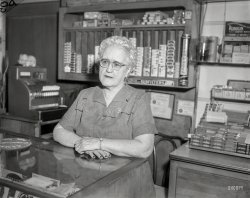
- Chicago & North Western: 1942
- December 1942. "One of the Chicago and North Western R.R. classification yards." 4x5 Kodachrome ...
I've been working on the railroad... ...in Chicago...in December...brrrrr.
This would be a tough time to be a ... dry snow, or maybe it's remembering the time when I was in Chicago on Thanksgiving with a totally inadequate coat waiting an hour for a ... Posted by Dave - 08/30/2012 - 4:43pm -
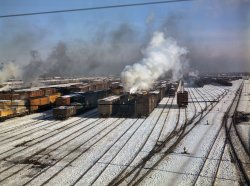
- Seeing Chicago: 1908
- Circa 1908. "Seeing Chicago, auto at Monroe near State." 8x10 inch dry plate glass negative by Hans ... of the 20th Century they expanded to many areas including Chicago.
In 1929 they merged into the Schulte's retail empire. Schulte's then ... the GMC truck line.
(The Gallery, Cars, Trucks, Buses, Chicago, DPC, Travel & Vacation) ... Posted by Dave - 08/20/2012 - 2:07pm -
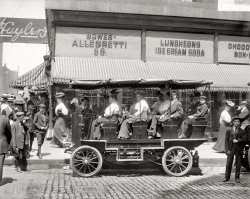
- Gangway for Andy: 1900
- Chicago circa 1900. "12th Street bascule bridge." Andy about to overtake A.B. Ward on the Chicago River. 8x10 inch dry plate glass negative. View full size.
... Bedtime Story Scuffy tows Mary Anne to her new home in Chicago's First Ward.
Few hues I don't think it would be much work to ... Posted by Dave - 05/15/2014 - 9:16am -
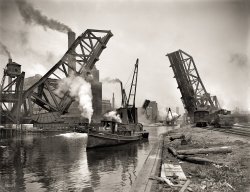
- Corwith Yard, Chicago: 1943
- ... about to leave for the West Coast from the Corwith yard in Chicago. March 1943. View full size. 4x5 Kodachrome transparency by Jack ... What a lucky guy Delano was to be able to travel from Chicago to LA on the ATSF, I would love to do that myself today with BNSF. I'll ... Posted by Dave - 07/30/2012 - 10:02pm -
![Corwith Yard, Chicago: 1943 Santa Fe freight about to leave for the West Coast from the Corwith yard in Chicago. March 1943. View full size. 4x5 Kodachrome transparency by Jack Delano, who went with the train to California, taking pictures along the way with his Graflex Speed Graphic. Look for them here in the coming days.
Color PhotographyDelano's color shots are amazing for that era, when color tended to be a little fuzzy and indistinct.
[After the introduction of Kodachrome film in the 1930s, color photography was probably as sharp or sharper than it is today, given the large-format cameras they had. It was print reproduction, whether in snapshots or magazines, that tended to suffer - Dave]
RR trip out westWhat a lucky guy Delano was to be able to travel from Chicago to LA on the ATSF, I would love to do that myself today with BNSF. I'll be looking forward to seeing his trip pictures on Shorpy soon. By the way this site is absolutely great, love seeing all the historical pictures of how things were 100 yrs ago. I know we couldn't live like that today with how much technology has changed us & the world.
Re: RR trip out westLook for more of those next week. In the meantime I've posted a Delano shot of a freshly painted caboose.
"I know we couldn't live"I know we couldn't live like that today with how much technology has changed us & the world."
But........ don't you wish we could!?
Stuff Greenies and Global Warming......bring back steam!
(The Gallery, Kodachromes, Chicago, Jack Delano, Railroads)](https://www.shorpy.com/files/images/1a34702u.thumbnail.jpg)
- Chicago Rodeo: 1941
- June 1941. "Trucks at Union Stockyards. Chicago, Illinois." Medium format acetate negative by John Vachon for the Farm ... I'm taken by the brickwork used as pavement. Chicago's fickle yet predictable weather could turn a dirt driveway into an ... It's a 3½-hour drive from Columbus Junction Iowa to the Chicago Stockyards. Who knows how many times Floyd E. Dean made the trip. ... Posted by Dave - 02/02/2020 - 3:35pm -
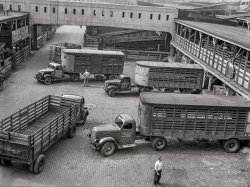
- Columbus in Chicago: 1911
- Chicago circa 1911. "Steamer Christopher Columbus ." 8x10 inch dry plate ... 1892-1893, it was exhibited at the Columbian Exposition in Chicago, and eventually scrapped in 1936.
What's Happening? Any ... in 1915 the SS Eastland capsized in while docked in the Chicago River with the loss of over 800 lives, officials subsequently ordered ... Posted by Dave - 10/12/2015 - 8:22pm -
![Columbus in Chicago: 1911 Chicago circa 1911. "Steamer Christopher Columbus." 8x10 inch dry plate glass negative, Detroit Publishing Company. View full size.
The One And OnlyAlthough several Steamships of the "Whaleback" style were built, The Christopher Columbus was the ONLY Passenger steamer of that design. Constructed in 1892-1893, it was exhibited at the Columbian Exposition in Chicago, and eventually scrapped in 1936.
What's Happening?Any idea what's going on here? The Columbus is under tow at both ends (apparently moving sideways). I don't imagine that was routine.
Stability testingWhen in 1915 the SS Eastland capsized in while docked in the Chicago River with the loss of over 800 lives, officials subsequently ordered many passenger ships to undergo stability testing, which the Columbus passed easily. Even with 7,500 sandbags (simulating passengers) piled on one side, and tugboats pulling in that direction, she listed only 12 degrees. Below is a photo of the testing.
I'm curious tooCould it be that the tug on the stern line is turning the ship while the tug on the bow line is holding in place until the ship is headed in the correct position to be towed to the dock.
Realistic sandbagsIf they are doing the stability testing in the photo those sandbags along the rails sure look like passengers to me.
[No one has said the Shorpy photo is of the stability test. -tterrace]
Tugboat practiceForty years ago I worked at Grangemouth Docks and often saw tugs doing their thing. It's a long time ago and few clear memories remain, but I've always thought it quite normal for tugs to work in pairs, one ahead and one astern of the larger vessel. The one ahead provides the main towing force while the other can act as a brake, and either/both can swing the ship around as required. Overall, two tugs allow much more control than one.
Swinging the shipI think the tugs are simply turning the ship around. It is usual practice to use two tugs, one on the bow and the other on the stern to swing a ship in confined waters. Malted Falcon mentions that the ship was tested for stability after the Eastland disaster but I don't think that is what is happening in this picture. The tug with the bow line is not the same one in the picture of the test and I don't think they would do the stability test with all those people on board.
[No one has said the Shorpy photo is of the stability test. -tterrace]
(The Gallery, Boats & Bridges, Chicago, DPC)](https://www.shorpy.com/files/images/SHORPY-4a16156a.thumbnail.jpg)
- Chicago: Night: 1943
- ... Central freight cars at the South Water Street terminal, Chicago. May 1943. View full size. 4x5 Kodachrome transparency by Jack ... appear to be dipping to the northwest. Given that the Chicago skyline was west of the lake, and the railway ran along the Lakeshore ... Posted by Dave - 08/05/2012 - 9:28am -
![Chicago: Night: 1943 Illinois Central freight cars at the South Water Street terminal, Chicago. May 1943. View full size. 4x5 Kodachrome transparency by Jack Delano.
Nights were darker back thenIt's interesting to compare this photo with the nighttime scene in any modern city - nowadays there are so many lights in the office buildings, while back then the offices were pitch black at night.
It seems there is a lit plane flying past the tower on the left...
[This was during World War II. There were blackout regulations in a lot of big cities, though mostly on the East Coast. - Dave]
Night photoGreat composition of light & dark, Jack sure knew how to take great photos. It looks like the boxcar is lit up by an auto's headlights.
[Jack used a floodlight. - Dave]
Line in upper left?What is that? Were commercial planes that common in 1943 like tsturm suggested?
[Aircraft running light? Whether military, civilian or interplanetary, it's hard to say. - Dave]
My guessThere are at least two streaks here, in the same trajectory. This glow is later dusk, nautical twilight, while these streaks are stellar in origin. The bright object is Venus.
This being shot in May, the zodiac would appear to be dipping to the northwest. Given that the Chicago skyline was west of the lake, and the railway ran along the Lakeshore back then, this is facing west-northwest.
Kodachrome of that day was either ASA8 or ASA10 speed, which is incredibly slow. Also, Kodachrome has poor reciprocity failure, meaning that it requires much more time to make very long exposures like this. Even time exposures with Kodachrome 64 in 2010 is pretty slow.
(Just to be sure, I pulled up Astroviewer.com's interactive night sky viewer, plugged in May 15, 1943, 8:50p CST, Chicago, and Venus is indeed in the western sky; the dimmer star is probably Theta Aurigae).
Nerd time over.
(The Gallery, Kodachromes, Chicago, Jack Delano, Railroads)](https://www.shorpy.com/files/images/1a34790u.thumbnail.jpg)
- Rita + Arthur: 1907
- The Chicago River circa 1907. "Canada Atlantic Transit freighter Arthur Orr ... When the passenger ship SS Eastland rolled over on the Chicago River in 1915 she was tied up at the Clark Street bridge, two blocks ... at the Dunham Towing and Wrecking Company plant along the Chicago River, Superintendent F. D. Fredericks, Charlie Hart, and Johnny ... Posted by Dave - 09/01/2023 - 3:13pm -
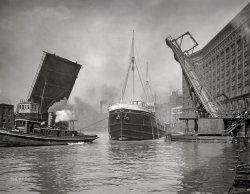
- Open Sesame: 1907
- Chicago, Illinois, circa 1907. "Jackknife Bridge, Chicago River." The Pueblo passing through the open span. Glass negative by ... is to narrow and to many buildings. Looking over the 1906 Chicago Public Works report, the direction of shadows and the fact that the ... Posted by Dave - 08/15/2012 - 3:06pm -
![Open Sesame: 1907 Chicago, Illinois, circa 1907. "Jackknife Bridge, Chicago River." The Pueblo passing through the open span. Glass negative by Hans Behm. View full size.
Sorry no bluesThis is not the Blues Brother Bridge. The river is to narrow and to many buildings. Looking over the 1906 Chicago Public Works report, the direction of shadows and the fact that the train is going over this bridge I suspect that it's the Lake Street bridge over the South Branch of the Chicago River. It's not Wells Street because that bridge goes north south. Problem is the Lake Street bridge had pavement added in 1907 & this one does not.
[The photo could have been made after 1907. - Dave]
More, info found. Lake St carried traffic and was paved in 1901. So no Lake St. This is an elevated track bridge that was located between Van Buren St and Jackson Blvd. It's on the maps of Chicago till sometime in the 50's. This was the one bridge for subway tracfic only in the loop. I found a few refence photos including the builders photos and no refence to location but South Branch of Chicago River. This is a Scherzer Rolling Lift Bridge built in 1895. I love this stuff and this website.
DrawbridgesThis drawbridge is the one at State street at W. Wacker drive. Apparently the Blues Brothers bridge is a different one.
The odd boatI believe that's the top of a mobile caisson used for underwater maintenance in those days.
Jackknife Bridge, Chicago RiverThis is probably the Lake Street bridge, which was replaced by a double-decker bridge a few years a few years after this photo. It looks like this today.
He moved the cameraMust have moved it a good seven or eight feet closer to the bridge. Interesting that something happened to the white napkin or handkerchief, too, on the side by the strange "turtle boat."
[I think the camera is in the same spot. This photo has been cropped. - Dave]
Pueblo of MilwaukeeI'd love to know more about the "Pueblo." It appears to be an old wooden-hulled sailing ship that has been converted to steam.
BatteredLooks like the Pueblo has had her share of bumps and bruises. Neat picture
We all live ...I recognize the boat in the foreground.
Pueblo (1891-1937)The Pueblo was built by the Milwaukee Shipyard in 1891. Renamed the Richard W in 1916 and finally the Palmbay in 1923. On Jan 16, 1926, she burned at her winter layup dock. Thought to be salvagable, but finally scuttled in Lake Ontario in 1937 without repair.
Jake and Elwood, where are you?Isn't this the bridge shown in "The Blues Brothers"?
Van Buren Street BridgeFrom the Chicago Postcard Museum.
Correction. This is not the Van Buren St Bridge but a bridge between Van Buren St and Jackson that is no longer there.
(The Gallery, Boats & Bridges, Chicago, DPC, Railroads)](https://www.shorpy.com/files/images/4a22367a.thumbnail.jpg)
- Chicago Noir: 1942
- December 1942. "Chicago, Illinois. Work goes on twenty-four hours a day at this Chicago and North Western Railroad yard." View full size. Medium format ... It's an interesting operation to watch.
(The Gallery, Chicago, Jack Delano, Railroads, WW2) ... Posted by Dave - 09/06/2011 - 1:38pm -
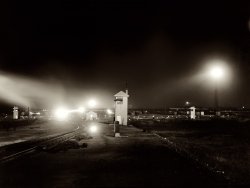
- Proviso Perspective: 1943
- April 1943. "Tracks at Chicago & North Western railroad's Proviso yard, Chicago." Kodachrome transparency by Jack Delano for the Office of War ... photo ... talk about vanishing points)
Good ol' Chicago -- Where the tracks are paved with gold.
It's not a ... Posted by Dave - 06/28/2022 - 4:50pm -
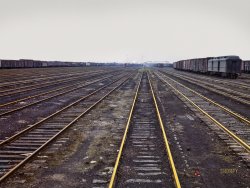
- Brooklyn Pin Boys: 1910
- ... Seven cents a game plus tips. I lasted about 4 hours.
Chicago Still have pinboys in Chicago at Southports Lanes on the northside.
Former Pin Boy My husband ... Posted by Dave - 09/08/2011 - 6:37pm -
![Brooklyn Pin Boys: 1910 April 1910. "1 a.m. Pin boys working in Subway Bowling Alleys, 65 South Street, Brooklyn, N.Y., every night. Three smaller boys were kept out of the photo by Boss." View full size. Photograph and caption by Lewis Wickes Hine.
notice the gas lightsnotice the gas lights
Slave DriverNot only did he hide all the nine year old kids when he saw the photographer, but I'll bet he also made sure his whip wasn't visible either.
muralI like the hint of the sailing mural on the back wall.Touch of class.
Bogotá 2006Reminds me of a bowling hall I visited in downtown Bogotá last year - pin boys and a musty basement smell
my dad was a pin boy. :]my dad was a pin boy. :]
Is that.......the dude from "Deadwood"?
The boss looks like......Al Swearengen from Deadwood
Pin Boy (Retired)I'm 78 now. I used to be a pin boy, part time nights in Hartford, Ct. from 1944 to 1947. The pay was much better than working on the tobacco farms after school.
man that job must haveman that job must have sucked did anyone ever throw the ball b4 u were done setting them??
Patrons intentionally bowling before pins were set.It happened routinely, especially later at night when the patrons were inebriated. However, you could usually expect a better tip from the drunk bowlers, especially if you would "help them along" by discreetly knocking over a few extra pins. We would occasionally taunt them and quickly jump over the safety wall as the ball was approaching.
One of only a handful remaining, there is still a public manual alley in Shohola, PA at Rohman's Hotel, It is cheap (1$ per frame) if you set your own pins or bring you own pin boy, (or girl).
http://www.riverreporter.com/issues/05-07-14/LR-wanda.html
73,
Tom
Good ole daysI worked lanes like these in the basement of a school attached to our church in Illinois. First time I ever saw a cork ball. And yes, they have thrown the ball down the lane before you had all pins set up, you just had to be quick enough to jump out of the way.
Then & NowPeople think they have it ruff now. Nice photo.
Got paid a nickel a line.I was a pinboy at age 12 in New Jersey in the fifties. Eight alleys no air conditioning, no breaks, no dental plan. But with tips you made a couple of bucks a night. Enough for a movie, comic books, a coke, and a pack of smokes. Today most folks have to work 8 hours to get all that stuff.
My First JobMy first job was as a pinboy at our local country club in New Jersey. Seven cents a game plus tips. I lasted about 4 hours.
ChicagoStill have pinboys in Chicago at Southports Lanes on the northside.
Former Pin BoyMy husband was a pin boy in 1953 at the Yonkers Jewish Center. He said your picture is exactly the way it was.
(The Gallery, Kids, Lewis Hine, NYC, Sports)](https://www.shorpy.com/files/images/04636u.thumbnail.jpg)
- Chicago and North Western: 1942
- General view of one of the Chicago and North Western railroad yards at Chicago. December 1942. View full size. 4x5 Kodachrome transparency by Jack ... Stone Park/Northlake area.
(The Gallery, Kodachromes, Chicago, Jack Delano, Railroads) ... Posted by Dave - 08/05/2012 - 9:30am -
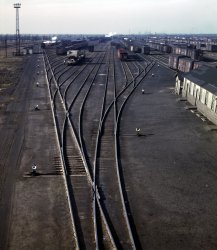
- Springtime in Chicago: 1941
- ... April 1941. Street scene in the Black Belt, South Side Chicago. View full size. 35mm nitrate negative by Edwin Rosskam for the Farm Security Administration.
(The Gallery, Chicago, Edwin Rosskam, Kids) ... Posted by Dave - 09/06/2011 - 1:44pm -
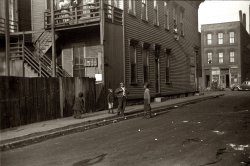
- Chicago Commuters: 1941
- July 1941. "Chicago, Illinois. Commuters waiting for southbound trains." 35mm acetate ... enough to pass through a wedding ring.
(The Gallery, Chicago, John Vachon, Railroads) ... Posted by Dave - 09/23/2020 - 1:06pm -
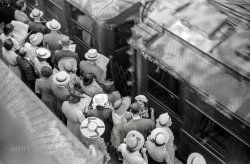
- Michigan Avenue: 1918
- Chicago circa 1918. "Michigan Avenue -- Blackstone Hotel and Grant Park." 8x10 ... These 50's replacements are still in use in most areas in Chicago proper. Later use of sodium vapor in the lighting elements, these newer fixtures have contributed to the "Orange-ing" of Chicago which sets the city streets apart from those of the suburbs.
Even ... Posted by Dave - 10/27/2015 - 10:48am -
![Michigan Avenue: 1918 Chicago circa 1918. "Michigan Avenue -- Blackstone Hotel and Grant Park." 8x10 inch dry plate glass negative, Detroit Publishing Company. View full size.
Trees, please. Thank you.
Amazinglythose multi-globed street lamps are still in use today.
Original Michigan Blvd. Lampposts The unique originals were replaced in the '50's by a bland street lighting design eventually used throughout the city. These 50's replacements are still in use in most areas in Chicago proper. Later use of sodium vapor in the lighting elements, these newer fixtures have contributed to the "Orange-ing" of Chicago which sets the city streets apart from those of the suburbs.
Even though these replica lampposts use sodium lamps (orange), I was glad to see them return!
Still looks beautifulFunny, with the decline of Detroit in the news so much I was expecting this hotel and entire block to be gone or abandoned. It's nice to see that the hotel appears to be as beautiful as it was in 1918.
[This is Chicago, though. -tterrace]
Oohh...Detroit PUBLISHING company. Thanks tterrace. I saw Detroit at the bottom in the description and got it in my head. Thanks for setting me straight. I had a moment of hope for Detroit! :)
+89Below is the same view from April of 2007.
Art Institute of ChicagoThat would be the Art Institute in the distance on this side of the street - also still there in the same building.
Stick It To 'EmThe billboard to the left of the Blackstone advertised Thrift Stamps that were being sold to the public to aid the Liberty Loan drive during WW1. They sold for 25 cents each.
and could eventually be traded for interest bearing War Bonds. We had similar stamps during WW2 but they could be purchased for as low as a dime.
BlackstoneI have stayed there a few times, actually. Neat old building. A ton of movies were filmed there too!
(The Gallery, Chicago, DPC)](https://www.shorpy.com/files/images/SHORPY-4a24940a.thumbnail.jpg)
- Crossing Dearborn: 1941
- July 1941. Crossing Dearborn Street in Chicago. View full size. 35mm nitrate negative by John Vachon for the FSA. ... Morrow's ad I can find is from 1933. - Dave]
Chicago Taxi Strange looking, I have never seen one like that before.
... stops at the lakefront.
Hope this helps!
Will
Chicago
Open air taxi? Am I seeing things or does the back seat in the ... Posted by Dave - 09/06/2011 - 1:39pm -
![Crossing Dearborn: 1941 July 1941. Crossing Dearborn Street in Chicago. View full size. 35mm nitrate negative by John Vachon for the FSA. What's the street we're looking down?
Morrow's Nut HouseI see a Morrow's Nut House; I had thought it was just in my hometown. It seems they are in a lot of places.
I've been trying to Google this name to see where and when it started. So far, even Wikipedia has nothing on it.
Can someone enlighten me as to where Morrow's Nut House got started?
[This article might be a good place to start. The earliest Morrow's ad I can find is from 1933. - Dave]
Chicago TaxiStrange looking, I have never seen one like that before.
Re: Vertical SeamsAnd then when the war came, they used some leg makeup and DREW the seams on with an eyebrow pencil. Nylons did not get rid of seams, really. It was a style.
Washington Street?My guess is that we're looking east down Washington Street. You can make out the name "Washington Shirt Co." on the building on the left. If you are heading east down Washington at the intersection with Dearborn, you are only 3-4 blocks from the open water, the reason there are no buildings in the background - Washington stops at the lakefront.
Hope this helps!
Will
Chicago
Open air taxi?Am I seeing things or does the back seat in the taxi to the left appear to be open air? It seems to be covered by an awning, with the back window removed. Good I guess for the summer, but they must have had to replace the window in the winter.
Vertical SeamsNote the seams on the stockings of the ladies in the left foreground. They took some care to get them perfectly straight. The invention of nylon stockings around 1939 or so did away with the seams, and also cut the cost of hosiery considerably from the silk ones. My grandmother told stories of hating to mess with those seams, trying to keep them straight.
Re: Open air taxi?The taxi is a Checker Model A landaulet. There are a few photos similar cabs here: http://www.coachbuilt.com/bui/c/checker/checker.htm
Hemmings link.
What cross street?Another vote for Washington Street. The sign for "Stop & Shop" can be seen below the big "Morrow's Nut House" panel. Some quick Google sleuthing came up with the old Stop & Shop gourmet market located on Washington Street between Dearborn and State. Washington Street now ends at Millennium Park.
Block 37It is indeed Washington Street; per the Chicago Tribune in 1935, Washington Shirt Company had occupied that corner since 1895. Which would make this the infamous Block 37, leveled in the late 1980s for a redevelopment scheme that fell through. It's only now being built up again. If you were standing there today, you would have your back to the plaza in front of Richard J. Daley center, home to the Picasso, and would be looking at the future studios of CBS Channel 2.
Highway ShieldThe sign we are seeing the back on the traffic light is for City US 20, which was located along Washington Street at that year.
Dearborn at Washington StreetThe real giveaway is, as someone else pointed out, Stop and Shop. One of our family's favorite stores. Also seen on the far right is Wiebolt's Department Store, defunct for quite a few years.
Wiebolt dept. storeThat building with ...BOLT on it is Lebolt's at 27 N. State St. They were a high end jeweler. Wiebolt's did not have a store in the Loop area until they took over Mandel Bros building in the '60s.
re: Vertical SeamsDan V wrote: "The invention of nylon stockings around 1939 or so did away with the seams..." Not entirely. I remember wearing seamed nylons in the 1960's and trying to keep them straight.
Washington Shirt CoMy grandfather was vice president of the Washington Shirt Company at this time.
(The Gallery, Cars, Trucks, Buses, Chicago, John Vachon)](https://www.shorpy.com/files/images/8a32750u_0.thumbnail.jpg)
- Pabst Backward: 1943
- ... the Illinois Central freight yard at South Water Street, Chicago." Kodachrome by Jack Delano. View full size.
"Time NOT ...
Thanks,
Cliff Shell
Fort Myers, FL
Memory of Chicago's old front yard I remember the old Pabst sign, I think it is ... Posted by Dave - 06/14/2017 - 11:51am -
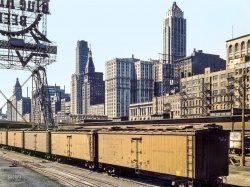
- The Chicago Kid: 1941
- April 1941. South Side Chicago boy. View full size. 35mm nitrate negative by Edwin Rosskam for the Farm Security Administration.
(The Gallery, Chicago, Edwin Rosskam, Kids, Portraits) ... Posted by Dave - 09/06/2011 - 1:44pm -
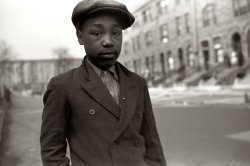
- Chicago & Alton: 1901
- Circa 1901. "Coaling station and water tank, C. & A. R.R., Mazonia, Illinois." 8x10 inch dry plate glass negative, Detroit Photographic Company. View full size.
Construction photo? Everything looks new! (Coal towers would get dirty ... Posted by Dave - 12/17/2020 - 11:19am -
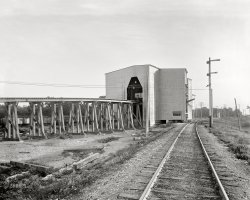
- Second City Riviera: 1942
- July 1942. "Chicago, Illinois. Lake Michigan beach." Medium format acetate negative by ...
More room for the beach towel The population of Chicago in 1940 was 3,396,808, the second largest city in the US.
Today, its ... neckerchief showing.
(The Gallery, Arthur Rothstein, Chicago, Swimming) ... Posted by Dave - 07/10/2023 - 12:36pm -
![Second City Riviera: 1942 July 1942. "Chicago, Illinois. Lake Michigan beach." Medium format acetate negative by Arthur Rothstein for the U.S. Foreign Information Service. View full size.
I believe that is correct.
The black at the neck would be his neckerchief and I think back then the rating or "rank" insignia was on the right sleeve, not the left, which is not visible in the photo.
+75Below is a very similar perspective from June of 2017 (it's the matched perspective from one of the several other shots Rothstein took of the beach that day).
What's Upwith the guy in white? Is that an early version of a hazmat suit?
[Beachside beekeeper. - Dave]
Sailor in the WindLooks like the guy in all white is a sailor in his crackerjacks and the wind has blown his tar flap over his head.
Mr. Hazmat suit.He looks like a sailor. Summer whites. The back flap is blowing up in the wind. You can see the back of his neckerchief behind his neck.
On The Home FrontWith the United States' entry into WWII just seven months prior, it's hard not to notice most of these beachgoers are women and children.
More room for the beach towelThe population of Chicago in 1940 was 3,396,808, the second largest city in the US.
Today, its around 2,608,425. Down about 23% in 80 years.
Re: What's Up?Regarding RG62's question about the guy in white, I believe he is a sailor in a US Navy white service undress uniform with the collar/tar flap on the back of his jumper blown up on his head.
As one who wore that uniformAnother vote for the Navy White enlisted uniform with the flap "Flapping in the Breeze" and the black neckerchief showing.
(The Gallery, Arthur Rothstein, Chicago, Swimming)](https://www.shorpy.com/files/images/SHORPY-8d06894a.thumbnail.jpg)
- Ice House: 1943
- ... ice storehouse of the Indiana Harbor Belt Railroad near Chicago. It has a storage capacity of almost 15,000 tons." Medium format ... ice for cooling. That particular railroad connected to the Chicago stockyards and so probably shipped a lot of refrigerated loads.
Ice ... Posted by Dave - 07/27/2023 - 11:35am -
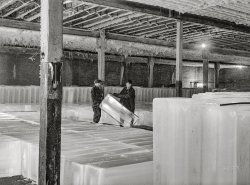
- Michigan Avenue: 1962
- Chicago, Illinois, circa 1962. At 10:27 a.m. Looking north along Michigan Avenue at Adams Street, with the Chicago Art Institute on the right. View full size.
What they ...
The Prudential Was the tallest building in Chicago at that time I believe. Also, my dad works there. Good view of Grant ... Posted by shawnv - 12/04/2008 - 12:05pm -
![Michigan Avenue: 1962 Chicago, Illinois, circa 1962. At 10:27 a.m. Looking north along Michigan Avenue at Adams Street, with the Chicago Art Institute on the right. View full size.
What they didn't knowJust think of all the things these drivers and pedestrians didn't know...
They didn't know there was going to be a band called the Beatles which would have such an impact on the culture
They didn't know that Vietnam would dominate the news and effect huge cultural change
They didn't know Kennedy would be killed within a year or so...
They didn't know that in 7 years the impossible would come true, men on the moon
They didn't know we'd become so dependent on some weird electronic device called a home computer
They hadn't heard of or seen: Doctor Zhivago (1965); Dr. Strangelove (1964); The Graduate (1967); A Hard Day's Night (1964); Mary Poppins (1964) etc etc etc
They never saw a roofed sports stadium (Astrodome 1965)
I love to ponder these things and try and get into the head of people in old photos... What are they thinking? What's important to them this day while they are turning left? Do they have a doctor's appointment? A first date? Cheers!
Wow.A pink Edsel in turn lane. Wish I had one today.
[Not quite. That's a Mercury. - Dave]
Car SpotterPart of me wishes I was 20 years old in 1962. I love the 1957 to 1962 cars. From left to right, 1959 Ford, looks like a 1956 Plymouth grille behind it, the photographer is following a 1957 Olds, and yes that is a pink 1957 Mercury. In front of that looks like a Checker Cab. Next to the Mercury is a 1962 Oldsmobile, and behind it is a 1955 Chevrolet. Behind the 55 Chevy is a 1960 Chevrolet.
The PrudentialWas the tallest building in Chicago at that time I believe. Also, my dad works there. Good view of Grant Park!
They also didn't know...... that the little black kid with the white mother would one day be President.
Michigan and Adams 2008Seems to be a new high-rise next to the Art Institute.
View Larger Map
Car StylingIf this picture were taken today, one wouldn't see much difference in car details. Most vehicles for the past 10 years have looked about the same. But in this picture, such amazing variety in just a seven-year span of models! Somehow, uniformity makes our society poorer.
So much has changed...... But one thing hasn't - THE TRAFFIC!
Chicago ..."My Kind of Town," so sayeth the chairman of the board.
MusicThis photo is best viewed while listening to The Thrashmens classic "Surfin' Bird"
Eerie how that happened to be playing here precisely when I saw this photo.
Changed?Honestly, this intersection really hasn't changed much. I recognized it right away. Go a few blocks in either direction, and there will be plenty of new stuff, but not at this intersection.
On a weekend with a car show, you could probably take nearly the same picture.
Car Styling I agree with you on that. It wasn't until recently that cars went through another design revolution. The minivans in the '90s and early '00s. At least now there are some differences between them. They all had the same shape and looked exactly the same from a distance back then. Same thing with mid-sized sedans. It was only in the last year or two that the cars gained some new distinguishing styles. Nothing beats the old cars though.
Palmolive Building mastThe tall silver mast on the Palmolive Building was the WGN-TV antenna back in those days. I believe it's used by an FM station now.
PrudentialThat's the Prudential Building with the mast. The Palmolive (a.k.a. Playboy) building is farther north and not visible in this photo.
That one modern buildingI walk by that spot all the time. The modern Prudential building dominating the photo was the first big Chicago skyscraper after a 20-year Depression/WWII hiatus.
Compare to all the buildings lining Michigan Ave which date from the 1910s and 1920s. Most are still there.
CarsAs for me and my family we would rather be in one these old big safe cars than the Tinkertoy cars of today.
[I'd rather be surrounded by six airbags and two crumple zones. The death rate per passenger-mile circa 1960 was pretty horrific. Those big old cars (and their passengers) did not do especially well in collisions. Roofs in the era of the wraparound windshield did a poor job of supporting the weight of the car in a rollover. - Dave]
No squabbleI was half as tall as my sister so the hump was my pillow. I loved to hear the rush and rumble of the road through the floor and, if my dad stopped too fast, I couldn't roll off.
ExactlyFeel the same way AJ, I can spend hours watching and analyzing every bit of these photos. Wish I had a time machine.
Old CarsThose old heavy cars used to have a lot of decapitations. The hood was solid and heavy and in a collision would release from the hinges and go back through the passenger compartment and slice off heads. As Dave stated, today's cars have crumple zones so the hood now just crumples up on impact... Much safer.
[Cars now are generally heavier than their counterparts 50 years ago, or at least denser. A 1959 Ford and 2009 Honda Accord both tip the scales at around 3,500 pounds. My Japanese car weighs a little over 4,100 pounds. - Dave]
Backseat SquabblersThe first car I remember was the family's green and white 1959 Ford Galaxie. My sisters and I used to fight over who got to sleep in the back window ledge on the way home when we would visit relatives in South Dakota. Winner got the package-shelf perch, second place got the back seat, loser ended up on the floor on hump. Actually we traded off, but the window shelf was prized. Riding like that with a Dad that smoked, it's a wonder we survived! Yikes.
1961It could have been taken in 1961, since the center green car is sporting a 1961 Michigan tag, which is the 59 yellow on green with a silver 1961 metal tab. Illinois had white on red plates in 1961, white on orange in 1962 - colors too similar to identify in the photo. Could also have been early 1962, but I think we’d notice both orange and red IL plates. As a kid in Chicago, I loved to see new plates appear each winter.
Route 66The white sign on the lamppost (in front of the lion) marks the beginning of Route 66.
Clues from the U.S. FlagWe featured this picture as our quiz #188 photo for the week of 14 Dec 2008. We essentially asked readers to identify the location and to tell us how they recognized it. See
www.forensicgenealogy.info/contest_188_results.html
We received many responses - one from regular reader Mike Dalton was worth writing to Shorpy about. Mike dated the picture to after July 4, 1960 based on the admission of Hawaii and Alaska to the Union in 1959. As Mike wrote:
Timeline referencing 50 star American flag in photo:
Alaska entered Union on January 3, 1959 - rank 49th state;
Hawai'i entered Union on August 21, 1959 - rank 50th state.
President Dwight David Eisenhower signed Executive Order 10834 on August 21,1959, regarding design and implementation of 50 star American Flag.
50 star American Flag raised officially for the first time at Fort McHenry National Monument in Baltimore, Maryland on July 4, 1960.
Since the flag on the front of the Art Institute of Chicago has 50 stars on it, the photo had to have been taken after July 4, 1960.
=====================================
[The earliest this could be is late 1961 -- that's a 1962 Oldsmobile under the Prudential tower. - Dave]
I am amazedDave. Your knowledge amazes me. Not many folks can identify a 1962 Olds.
Ferris BuellerIf you ever saw Ferris Bueller's Day Off, you could see this is the Art museum from that movie. It shows the lions at the beginning of the museum montage played to the instrumental version of "Please Please Please Let Me get what I Want" by Dream Academy. Great movie.
Some things never changeThe spectacular "Lions of Michigan Avenue" in front of the Art Institute, placed there in 1894, are considered the best work of artist Edward Kemeys. They're not identical; the lion on the north pedestal is "on the prowl" while the one on the south pedestal is "in an attitude of defiance." I have pictures of my family in front of the south lion when our children were small. We used to eat at Bennigan's (no longer there) directly across the street, gazing (if we were lucky enough to get a window table) out at the Art Institute and the southern end of the Magnificent Mile. I took a picture looking west down Adams Street towards the Sears Tower (it has another name now but I never use it) from this very spot in late September of 2019. Then there's that lovely peek of the Wrigley Building glowing in the distance to the north -- Michigan Avenue at Wacker Drive, where the Chicago River flows beneath the DuSable Bridge.
(ShorpyBlog, Member Gallery, Cars, Trucks, Buses)](https://www.shorpy.com/files/images/chicago_2.thumbnail.jpg)
- Wabash Avenue El: 1907
- From 1907, a bird's-eye view of Wabash Avenue in Chicago, showing the celebrated "El," or elevated railway, as well as a number ... in a neighborhood called Jefferson Park in the city of Chicago. Is there any pics from my area available do you think? Please contact ... Posted by Dave - 07/30/2012 - 10:01pm -
![Wabash Avenue El: 1907 From 1907, a bird's-eye view of Wabash Avenue in Chicago, showing the celebrated "El," or elevated railway, as well as a number of piano manufacturers and the National Casket Company. Detroit Publishing Co. View full size.
More pics from Chicagoland Area?Hello,
I live in a neighborhood called Jefferson Park in the city of Chicago. Is there any pics from my area available do you think? Please contact me if you do come across any.
Thanks,
WOLF
Reprint?I'm trying to get a reprint of this pic from the detroit publishing co. but the original has a large black spot on the lower left corner. How did you manage to get this pic w/o the spot? And how can I get a reprint like yours?
[Click on one of the Juniper Gallery links under the caption. - Dave]
Piano Row - ChicagoThis is looking north on Wabash Avenue at Van Buren Street. This section of Wabash was known for its wealth of shops that sold musical instruments, such as pianos, and sheet music.
The last of the piano and music vendors, the Lyon~Healy Company, was purchased by De Paul University for the expansion of its downtown campus, maybe 20 years ago.
To-dayThe buildings on the right no longer exist - CNA Insurance is there now (44 story red building - pretty easy to pick out in a current day skyline picture of Chicago). To the left of the tracks is now a parking lot.
(The Gallery, Chicago, DPC, Railroads)](https://www.shorpy.com/files/images/SHORPY_4a22373a.thumbnail.jpg)
- 30 Rock: 1933
- ... in the world that looked like this: New York City and Chicago.
One can vicariously put oneself into the shoes of some kid from ... Posted by Dave - 07/17/2012 - 10:22pm -
![30 Rock: 1933 New York. December 5, 1933. "Rockefeller Center and RCA Building from 515 Madison Avenue." Digital image recovered from released emulsion layer of the original 5x7 acetate negative. Gottscho-Schleisner photo. View full size.
City of the godsIn 1933, my father was a seven-year-old living up Lick Branch Hollow in the Ozark Mountains. He would read books by kerosene light in the evenings. His family kept butter and milk (and Uncle Linus' hooch) in the cold spring-fed creek outside their house. It's astonishing to think he could have boarded a train and eventually arrived in this city of the gods, only a thousand miles away.
Sign of the CrossThe double bar cross was the emblem used by the National Tuberculosis Association. Wonder if the lights were part of the campaign to fight TB.
Gotta love those whitewalls!On the convertible by the front door. Double O's. Looks like it's ready to go somewhere in a hurry.
Released emulsion layer?Dave, can you explain the technology of this image? How does an emulsion layer get released from a negative?
[This is a process used on deteriorating acetate transparencies and negatives when they've begun to shrink. The negative is placed in a chemical solution that separates the emulsion from the film base. The released emulsion layer (the pellicle) is then placed in another solution to "relax," or unwarp, it. It's kind of like disappearing your body so that only the skin is left. More here. - Dave]
Amazing viewThe shot is incredible! It looks almost surreal. I love it!
Awesome scan job.I only wish I could see an even higher res version. Great work bringing this one back to life.
WowI just can't believe how beautiful this shot is. Looks like the view from my New York Penthouse sitting there drinking martinis and listening to that new "jazz" music.
High DramaThis marvelous building, reaching for the sky as if erupting from the ground, combines amazing delicacy, impressive size, and a feeling it is built for the ages to admire. SO much more breathtaking than today's typical glass box, although you need a view like this to really appreciate the classical lines and artful massing. A nice complement to the gothic cathedral in the foreground - a true temple of commerce!
Churchly And Corporate SpiresThat's St. Patrick's Cathedral on the lower left, probably the only building from the 19th century left on Fifth Avenue, except for the Chancery House that's attached to it.
Both styles of architecture are very dramatic. When I was a small child, at Christmas, my family would go to the Christmas Pageant at Radio City Music Hall every year, and then attend Midnight Mass at St. Patrick's.
Ever since, I've never been able to separate religion from showbiz. Possibly because they really are the same thing.
Take a peekThis picture makes me want to get out the binoculars and look in the windows.
"Don't get much better"This image is a about as close to textbook perfect BW as you will find. It contains the complete range of grays from what looks like solid black in a few places to solid white in the highlights. The camera was level and the focus was dead on. As a photographer, I am envious.
Old shooter
Reaching New HeightsThe skyscraper is 30 Rockefeller Plaza before the RCA and current GE neon signage. Not that it wasn't famous before, but the TV show "30 Rock" has made it an even more iconic. Another claim is the gigantic Christmas tree on the Plaza, between the building and the skating rink, that when illuminated kicks off the Holiday Season in NYC.
Hugh FerrissThis is like the photographic equivalent of one of Hugh Ferriss' architectural drawings, coincidentally of roughly the same era.
MagicThe quality of this incredible photo captures the magic that New York City always longs for but seldom delivers.
King Kong might have had a chance...had he chosen 30 Rock instead.
OKLo mismo digo.
Gracias.
American Express BuildingThat hole in the ground, I believe, bacame the American Express Building. If you come out of the subway at the Rockefeller Center stop, and come up on the escalator in that building, you get an incredible view of St Pat's from below, with the spectacular statue of Atlas in the foreground as well. Very cool.
Other noteworthy background details here include the Hotel Edison, and the old NY Times Building, at Times Square, before they went and utterly ruined it in the 60's by stripping all the detail off the skeleton.
And check the skylights on the roof of what I think is the Cartier store, in the foreground!
Send this to Christopher NolanHere's the art direction for the next Batman sequel.
SpectacularWhat a wonderful, wonderful image! I love coming to Shorpy because you never know what Dave will come up with next.
Thanks so much!
The GreatestDave, this has to be one of the greatest photos you have posted. I work around the corner, and can look out my window at 30 Rock from 6th Avenue... my building wasn't built until 1973. Thank you.
Time stoppedIs it 2:25am or 5:10am?
Can you spot the clock?
What Gets MeLooking at this photo - and it looks spectacular on my new monitor - is the sky. It has a sort of foggy twilight quality that is difficult to put into words but which emphasizes the the "star" of the photo - the RCA Building - and its nearby consorts or supporting cast over the buildings in the background which seem to fad into the mist.
The building seems like the height of modernity, and one can easily imagine a couple of kids from Cleveland named Siegel and Shuster seeing this and making it a model for the cities of the doomed planet Krypton.
Very neat picture...Can you give us an idea of what it looked like before it was restored?
[There's an example here. - Dave]
StunnedWhat a totally wonderful image, Sat here slack jawed at the incredible detail and the superb composition.
I am amazedThe detail in the spires at St. Paul's Patrick's is fantastic. The amount of work that went into that building must have been enormous. I am very grateful not to have been on the crew detailed to put the crosses atop the spires!
The Future Is NowInteresting that this photograph looks into a future in which many of the same buildings are still with us. At far left midground is the tower of Raymond Hood's American Standard Building. Next to it, with the illuminated sign on top, is the New Yorker Hotel (now Sun Myung Moon's) where Nikola Tesla spent the last ten years of his life. At center is the N.Y. Times Building with its flagpole convenient for deploying the New Year's Eve ball. And last, but not least, the Paramount Building topped by a globe and illuminated clock which is about as close to the Hudsucker Building as could hope to be seen. Of these four only the appearance Times Building has changed to any extent. A wonderful slice of time.
TremendousTwo of my favorite photos on Shorpy consist of those like this one, showing the immense power of a huge city, even in the depths of the Depression, and those of small towns, especially when patriotic holidays were still celebrated.
Samuel H. GottschoI'd never heard of him, but one look at this photo and I'm instantly a fan. This image is nothing short of spectacular.
Ethereal, PowerfulThere have been many photos on this site that have impressed and pleased me, but this one is one of my favorites. Absolute magic. It's the quintessence of the power and style of 1930s design.
Time machineI admire NY photos of the 1950s. And now I see that many of the buildings in NY I admire already were erected in early 1930s! What a discovery. What a shot.
The Singularity of the MomentThis is an amazing photograph.
As one earlier contributor observed, the pure technical aspects of the black and white composition are fabulous. The spread of detailed gray shadows and whites make this photo almost magical. It has the qualities of an Ansel Adams zone photograph that makes his work so arresting.
But what really makes this photograph dramatic is what it reveals about New York City in 1933.
A vision of the future of large cities, bustling twenty four hours a day and electrified. Today visions such as these can be seen on any continent in any large city. It has become the norm. But in 1933 there were only two places in the world that looked like this: New York City and Chicago.
One can vicariously put oneself into the shoes of some kid from rural America or from Europe setting on Manhattan Island and seeing visions such as these for the first time. I can only guess it had the same effect as it had on 14th-century peasants in France, visiting Paris for the first time and entering the nave of the Notre Dame Cathedral.
Beautifully put!I'm sure Samuel Gottscho would have been very gratified to know thoughtful and eloquent people like Bob H would be appreciating his work in the 21st century.
PenthouseIs the Garden Patio still across the street from the skylights?
I am in love with this photographExquisite doesn't even begin to describe it.
In Your Mind's EyeYou can smell and feel the air and hear the traffic.
It may be calm now...I have a feeling that all hell is about to break loose -- this picture was taken the day Prohibition was repealed.
I worked hereI worked here in the 1960s for the "Tonight" show unit as as a production assistant for Dick Carson, brother of Johnny Carson. An attractive, dark-haired woman named Barbara Walters was working at the "Today" show at the same time. She is about 10 years older than I am.
I also worked with the News department for a time. I was in the elevator with David Brinkley coming back from lunch when I learned that President Kennedy had been shot. We stayed up all Friday night and most of Saturday assembling film footage for a retrospective of JFK's life. When we weren't editing, we were visiting St. Patrick's Cathedral to light candles with others in the crowd.
That's an absolutely amazing photo. I'm going to link this to other New Yorkers and broadcasters who might be interested.
Thanks for all your work.
Cordially,
Ellen Kimball
Portland, OR
http://ellenkimball.blogspot.com
30 RockIs the excavated area where the skating rink is? I've been there once and it is very magical. Right across the street from the "Today" studio.
Tipster's PhotoStunning, but in a different way than Gottscho's. It helps when the subject is beautiful.
30 Rock 09
Here's the view today made with a 4x5 view camera, farther back seen through the St. Patrick's spires and somewhat higher than the 1933 photo. Lots more buildings now. I was doing an interior architectural shoot, and went out on the terrace of a wedding-cake building on Madison Avenue. It was after midnight. Not much wind. Strangely quiet.
As an architectural photographer I have great admiration for these Gottscho pictures.
30 Rock in Living ColorThat's a lovely photo, and it's nice to see the perspective so close to that of the original.
Design Continuum of Bertram GoodhueThe proximity of St. Patrick's Cathedral to the newly constructed tower by Raymond Hood brought to mind two "bookends" to the unfulfilled career of Bertram Goodhue. During his early apprenticeship he undoubtedly worked on the St. Patrick's Cathedral, in Renwick's office, which greatly influenced his early career and success. The tower (30 Roc) represents what might have been...rather what should have been the end result of Goodhue's tragically shortened career (ending in 1924). Hood's career, which began to emerge after Goodhue's death is far better known, but is greatly in his debt. Hood's 1922 Tribune Tower clearly displays this link, as a practitioner of the neo-gothic style. Much of Hood's gothic detail is a through-back to design ideas that by 1922, Goodhue had already left behind.
Goodhue was by this time already synthesizing elements of european modernism into an new original american idiom. Goodhue's last major projects were already working out the language of the modern/deco skyscraper; (the Nebraska State capital and Los Angles Public Library the best examples.) Goodhue's unique career was the crucible where concepts of romantic imagery of the Gothic, the sublime juxtapositions of minimal ornament on architectonic massing was being forged with modern construction technology. A close study of his career and work will show that not only Hood, but other notable architects of the era built upon the rigorous and expansive explorations that Goodhue was beginning to fuse at the end of his life.
*It is also curious to me that Hugh Ferris is credited with so much of these innovative design ideas; no doubt he was a super talented delineator, his freelance services were utilized by many architects of the time including Goodhue. Some of his famous massing studies (sketches) owe much to Goodhue's late work.
Amazing Execution and RestorationI agree with "Don't get much Better" ! This is as good as it can get for B&W. The exposure is so right-on and this in 1933!! Is this a "night" shot.. there is a lot of ambient light. Simply Amazing. I want it!
Rock RinkThe not-yet-built skating rink is in front of the building. The empty space became 630 Fifth Avenue, where a statue of Atlas stands.
Vanderbilt Triple PalaceA long time since this was posted, but I am surprised no one recognized the southern half of the iconic, brownstone-clad Vanderbilt Triple Palaces in the foreground (640 Fifth Avenue), just opposite the lower edge of the excavated building site.
The northern half, with two residences, had been sold, demolished & replaced a long time ago, but the southern half stood until 1947 (Grace Wilson Vanderbilt continued entertaining in her usual style until WWII).
The entrance vestibule to the three residences featured a nine foot tall Russian malachite vase, once given by Emperor Nicholas I of Russia to Nicholas Demidoff, now on display at the Metropolitan Museum of Art a couple of dozen blocks north on Fifth.
(The Gallery, Gottscho-Schleisner, NYC)](https://www.shorpy.com/files/images/05853u1.thumbnail.jpg)
- Jackknife Bridge: 1907
- Chicago circa 1907. "Jack-Knife Bridge, Chicago River." 8x10 inch dry plate glass negative by Hans Behm, Detroit ...
See that piece of wood? I used to row on the Chicago River. It's actually one of the best rivers in the US for rowing. ... Posted by Dave - 08/09/2012 - 11:56pm -
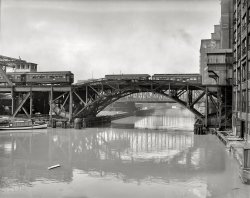
- The City That Works: 1943
- Chicago, April 1943. "General view of part of the South Water Street Illinois ... by Jack Delano for the Office of War Information.
Chicago I worked in the Wrigley Building the last 8 years, I love seeing ... in place to protect carmen.
(The Gallery, Kodachromes, Chicago, Jack Delano, Railroads) ... Posted by Dave - 07/30/2012 - 10:05pm -
![The City That Works: 1943 Chicago, April 1943. "General view of part of the South Water Street Illinois Central Railroad freight terminal." View full size. 4x5 Kodachrome transparency by Jack Delano for the Office of War Information.
ChicagoI worked in the Wrigley Building the last 8 years, I love seeing pics of what the area was like. Hard to picture the rail where skyscrapers are now, and with the Trump Tower behind.
State of the BuildingsThey are so dirty! Obviously the smog at times was unbelievable from the trains.
[Soot. - Dave]
South Water Yard and freight houseAt least some of those tracks were there into the 1970s and early 1980s. I remember seeing strings of Illinois Central Gulf boxcars parked there, visible from the Outer Drive.
My father was in that freight house around 1950, when he was with New York Central. He recalled the flooring was of hardwood blocks with the end grain facing up.
He also recalled being there with a survey crew on another occasion when it was cold out, and his crew had to go to a nearby switch shanty to warm up. There was some guy in there, probably fresh from the old country, who smelled like he ate nothing but raw onions and garlic. He and his coworkers lingered there just long enough to get warm and RAN out of there!
ProtectionI like the particularly bright blue flags in place to protect carmen.
(The Gallery, Kodachromes, Chicago, Jack Delano, Railroads)](https://www.shorpy.com/files/images/1a34785u.thumbnail.jpg)























